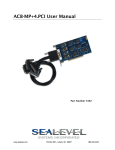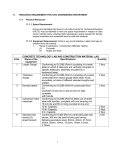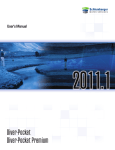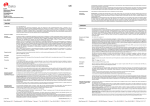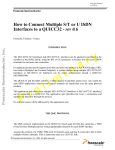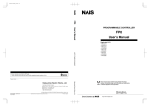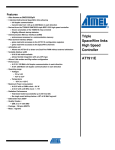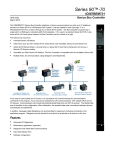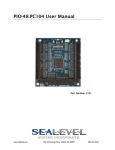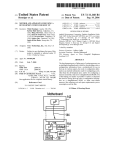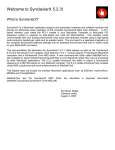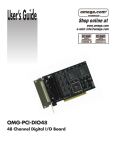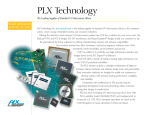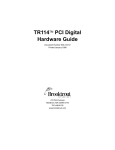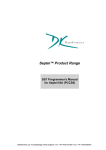Download NPMC-BRI User`s Manual
Transcript
N.A.T. PMC-860-4S0 Technical Reference Manual NPMC-860-4S0 CPU PMC Module Technical Reference Manual V1.6 HW Revision 2.0 N.A.T. PMC-860-4S0 Technical Reference Manual The NPMC-860-4S0 has been designed by: N.A.T. GmbH Kamillenweg 22 D-53757 Sankt Augustin Phone: ++49/2241/3989-0 Fax: ++49/2241/3989-10 E-Mail: [email protected] Internet: http://www.nateurope.com Version 1.6 © N.A.T. GmbH 2 N.A.T. PMC-860-4S0 Technical Reference Manual Disclaimer The following documentation, compiled by N.A.T. GmbH (henceforth called N.A.T.), represents the current status of the product´s development. The documentation is updated on a regular basis. Any changes which might ensue, including those necessitated by updated specifications, are considered in the latest version of this documentation. N.A.T. is under no obligation to notify any person, organization, or institution of such changes or to make these changes public in any other way. We must caution you, that this publication could include technical inaccuracies or typographical errors. N.A.T. offers no warranty, either expressed or implied, for the contents of this documentation or for the product described therein, including but not limited to the warranties of merchantability or the fitness of the product for any specific purpose. In no event will N.A.T. be liable for any loss of data or for errors in data utilization or processing resulting from the use of this product or the documentation. In particular, N.A.T. will not be responsible for any direct or indirect damages (including lost profits, lost savings, delays or interruptions in the flow of business activities, including but not limited to, special, incidental, consequential, or other similar damages) arising out of the use of or inability to use this product or the associated documentation, even if N.A.T. or any authorized N.A.T. representative has been advised of the possibility of such damages. The use of registered names, trademarks, etc. in this publication does not imply, even in the absence of a specific statement, that such names are exempt from the relevant protective laws and regulations (patent laws, trade mark laws, etc.) and therefore free for general use. In no case does N.A.T. guarantee that the information given in this documentation is free of such third-party rights. Neither this documentation nor any part thereof may be copied, translated, or reduced to any electronic medium or machine form without the prior written consent from N.A.T. GmbH. This product (and the associated documentation) is governed by the N.A.T. General Conditions and Terms of Delivery and Payment. Note: The release of the Hardware Manual is related to a certain HW board revision given in the document title. For HW revisions earlier than the one given in the document title please contact N.A.T. for the corresponding older Hardware Manual release. Version 1.6 © N.A.T. GmbH 3 N.A.T. PMC-860-4S0 Technical Reference Manual Table of Contents LIST OF TABLES .................................................................................................................................................5 LIST OF FIGURES ...............................................................................................................................................5 CONVENTIONS....................................................................................................................................................6 1 INTRODUCTION..........................................................................................................................................7 2 INSTALLATION .........................................................................................................................................10 2.1 SAFETY NOTE .........................................................................................................................................10 2.2 INSTALLATION PREREQUISITES AND REQUIREMENTS ..............................................................................11 2.2.1 Requirements..................................................................................................................................11 2.2.2 Power supply..................................................................................................................................11 2.2.3 Location Overview .........................................................................................................................12 2.3 AUTOMATIC POWER UP ..........................................................................................................................13 2.4 STATEMENT ON ENVIRONMENTAL PROTECTION .....................................................................................13 2.4.1 Compliance to RoHS Directive ......................................................................................................13 2.4.2 Compliance to WEEE Directive.....................................................................................................14 3 HARDWARE DETAILS.............................................................................................................................15 3.1 MEMORY MAP ........................................................................................................................................15 3.2 POWERQUICC PORT PINS USAGE ..........................................................................................................16 3.3 INTERRUPT STRUCTURE ..........................................................................................................................18 3.4 CONTROL / STATUS REGISTERS...............................................................................................................19 3.4.1 Status Register 1.............................................................................................................................19 3.4.2 Control/Status Register 2 ...............................................................................................................19 3.4.3 Status Register 3.............................................................................................................................20 3.5 IDL BUS OPERATION ..............................................................................................................................21 3.6 TIME DIVISION MULTIPLEX BUS STRUCTURE .........................................................................................21 3.7 S/T PORT SETUP .....................................................................................................................................22 4 CONNECTORS ...........................................................................................................................................23 4.1 CONNECTOR OVERVIEW .........................................................................................................................23 4.2 SWITCH SETTINGS ...................................................................................................................................23 4.3 PMC CONNECTOR P11 ...........................................................................................................................24 4.4 PMC CONNECTOR P12 ...........................................................................................................................25 4.5 PIN ASSIGNMENT OF THE PMC CONNECTOR -- P14 ( PMC I/O ) ........................................................26 4.5.1 Description P14 Signals.................................................................................................................27 4.5.2 SCbus IDs.......................................................................................................................................27 4.6 THE FRONT PANEL CONNECTORS (S1 - S4) ............................................................................................28 4.7 CONNECTOR JP1: MOTOROLA BACKGROUND DEBUG MODE (BDM) ....................................................29 4.8 CONNECTOR JP2: LATTICE PROGRAMMING PORT...................................................................................29 5 SOFTWARE APPLICATION NOTES .....................................................................................................30 5.1 5.2 5.3 HOST SETUP OF THE QSPAN II PCI BRIDGE ............................................................................................30 Q-BUS CONFIGURATION .........................................................................................................................32 EEPROM CONFIGURATION ....................................................................................................................32 Version 1.6 © N.A.T. GmbH 4 N.A.T. PMC-860-4S0 Technical Reference Manual ANNEX A POWERQUICC CPU......................................................................................................................33 ANNEX B QSPAN IITM BUS BRIDGE ............................................................................................................35 ANNEX C RAM/ROM .......................................................................................................................................36 ANNEX D DOCUMENTATION REFERENCE .............................................................................................37 ANNEX E DOCUMENT’S HISTORY .............................................................................................................38 List of Tables TABLE 1: TABLE 2: TABLE 3: TABLE 4: TABLE 5: TABLE 6: TABLE 7: TABLE 8: TABLE 9: TABLE 10: TABLE 11: TABLE 12: TABLE 13: TABLE 14: TABLE 15: TABLE 16: TABLE 17: TABLE 18: TABLE 19: LIST OF USED ABBREVIATIONS ..........................................................................................................6 NPMC-860-4S0 MEMORY MAP ....................................................................................................15 POWERQUICC PORT PIN USAGE (PORT A) ....................................................................................16 POWERQUICC PORT PIN USAGE (PORT B) ....................................................................................16 POWERQUICC PORT PIN USAGE (PORT C) ....................................................................................17 POWERQUICC PORT PIN USAGE (PORT D) ....................................................................................17 NPMC-860-4S0 INTERRUPT STRUCTURE.......................................................................................18 STATUS REGISTER 1 ........................................................................................................................19 CONTROL/STATUS REGISTER 2 .......................................................................................................20 STATUS REGISTER 3 ........................................................................................................................20 PMC CONNECTOR P11 ...................................................................................................................24 PMC CONNECTOR P12 ...................................................................................................................25 PIN ASSIGNMENT OF THE PMC CONNECTOR -- P14.......................................................................26 DESCRIPTION P14 SIGNALS.............................................................................................................27 GENERAL PIN ASSIGNMENT OF THE FRONT-PANEL CONNECTORS S1 - 4 ........................................28 JP1 BDM AND IEEE 1149.1 CONNECTOR PINOUT OPTIONS ..........................................................29 LATTICE PROGRAMMING PORT .......................................................................................................29 NPMC-860-4S0 MEMORY MAP IN THE CONFIGURATION SPACE......................................................30 NPMC-860-4S0 MEMORY MAP IN THE PCI MEMORY SPACE ..........................................................31 List of Figures FIGURE 1: FIGURE 2: FIGURE 3: FIGURE 4: FIGURE 5: FIGURE 6: Version 1.6 NPMC-860-4S0 ON A VMEBUS CARRIER ........................................................................................7 NPMC-860-4S0 BLOCK DIAGRAM ..................................................................................................8 LOCATION DIAGRAM OF THE NPMC-860-4S0 (SCHEMATIC)..........................................................12 TDM BUS ORGANISATION AND SYNCHRONISATION .......................................................................21 S/T PORT SETUP .............................................................................................................................22 CONNECTORS OF THE NPMC-860-4S0...........................................................................................23 © N.A.T. GmbH 5 N.A.T. PMC-860-4S0 Technical Reference Manual Conventions If not otherwise specified, addresses and memory maps are written in hexadecimal notation, identified by 0x. Table 1 gives a list of the abbreviations used in this document: Table 1: List of used Abbreviations Abbreviation Description b B CPU DMA Flash H.110 ISDN K LIU M MHz ML53812 MPC860 PowerQUICC Qbus QSpan II RAM ROM SCbus Bit, binary byte Central Processing Unit Direct Memory Access Programmable ROM Time-Slot Interchange Bus Integrated Services Digital Network kilo (factor 400 in hex, factor 1024 in decimal) Line Interface Unit mega (factor 10,0000 in hex, factor 1,048,576 in dec) 1,000,000 Herz Oki H.110 Controller Embedded processor from Motorola MPC860 PowerPC processor bus Tundra PCI Æ 60x bus interface device Random Access Memory Read Only Memory Time-Slot Interchange Bus of the SCSA, subset of H.110 bus Serial Communication Controller of the MPC860 Signal Computing System Architecture Synchronous Dynamic RAM Serial Communication Controller of the MPC860 Static RAM framer and line interface for basic rate ISDN Time Division Multiplex Time Slot Assigner Time Slot Interchange SCC SCSA SDRAM SMC SRAM S/T port TDM TSA TSI Version 1.6 © N.A.T. GmbH 6 N.A.T. PMC-860-4S0 Technical Reference Manual 1 Introduction The NPMC-860-4S0 is a high performance standard CPU PCI Mezzanine Card Type 1. It can be plugged onto any carrier board supporting PMC standards: Figure 1: NPMC-860-4S0 on a VMEbus carrier P2 P1 NVME-PMC NPMC-8260-4E1 (Back View) NPMC-860-4S0 (Back View) The NPMC-860-4S0 has the following mayor features on-board: • PowerQUICC MPC860 based Embedded PowerPC Architecture • Front-panel I/O • PCI Bus interface • Single Slot VME/cPCI solution together with the PMC carrier board Version 1.6 © N.A.T. GmbH 7 N.A.T. PMC-860-4S0 Technical Reference Manual Figure 2: PCI Bus QSPAN II PCI <=> Qbus Bridge QBus 4 / 16 MByte DRAM NPMC-860-4S0 Block Diagram 33/40/50 MHz Oscillator S0 Line Interface MPC860 Power QUICC S0 Line Interface Connector S0 Line Interface Connector S0 Line Interface Connector SPI Connector 40/50/66/80 MHz Flash 2 / 4 MByte H.110 / SCbus IDL-Bus TDM ML53812 TSI The onboard devices are in detail as follows: • Memory DRAM: The NPMC-860-4S0 provides 4 or 16 MByte EDO DRAM onboard. The DRAM is 32 bit wide. Flash PROM: The 8 bit boot Flash PROM provides a maximum capacity of 4 MByte. • Interfaces PCI: The NPMC-860-4S0 includes a 32 bit 33 MHz PCI bus interface. • I/O The 4 S0 line interfaces are connected to the front panel connectors. The SCbus is connected to the PCI I/O connector. Version 1.6 © N.A.T. GmbH 8 N.A.T. PMC-860-4S0 Technical Reference Manual • CPU Depending on the assembled CPU type the PowerQUICC runs with a minimum frequency of 50 MHz. (40 MHz, 66 MHz, or 80 MHz versions are optionally available) 1.1 Specification Processor PowerQUICC MPC860 PMC-Module Standard PCI Mezzanine Card Type 1 PCI to QBUS bridge QSPAN II I/O 4 RJ45 connectors Main Memory 4 / 16 MByte EDO DRAM Flash PROM 2 / 4 MByte Flash PROM, on-board programmable Firmware OK1, PSOS BSP, VxWorks BSP (on request) Power consumption 3.3V 0,8A 5.0V 0,5A Environm. conditions Temperature (operating) Temperature (storage) Humidity Standards compliance Version 1.6 0°C to +50°C -40°C to +85°C 5 % to 95 % noncondensing PCI Rev. 2.2 P1386.1 / Draft 2.4 © N.A.T. GmbH 9 N.A.T. PMC-860-4S0 Technical Reference Manual 2 Installation 2.1 Safety Note To ensure proper functioning of the NPMC-860-4S0 during its usual lifetime take the following precautions before handling the board. CAUTION Malfunction or damage to the board or connected components Electrostatic discharge and incorrect board installation and uninstallation can damage circuits or shorten their lifetime. • Before installing or uninstalling the board read this installation section • Before installing or uninstalling the NPMC-860-4S0, read the Installation Guide and the User’s Manual of the NPMC-860-4S0 carrier board • Before installing or uninstalling the NPMC-860-4S0 on a carrier board or both in a VME/cPCI rack: - Check all installed boards and modules for steps that you have to take before turning on or off the power. - Take those steps. - Finally turn on or off the power. • Before touching integrated circuits ensure to take all require precautions for handling electrostatic devices. • Ensure that the NPMC-860-4S0 is connected to the carrier board via all PMC connectors and that the power is available on both PMC connectors (GND, +5V, and +3,3V). • When operating the board in areas of strong electromagnetic radiation ensure that the module - is bolted the front panel or VME/cPCI rack - and shielded by closed housing. Version 1.6 © N.A.T. GmbH 10 N.A.T. PMC-860-4S0 Technical Reference Manual 2.2 Installation Prerequisites and Requirements IMPORTANT Before powering up • check this section for installation prerequisites and requirements 2.2.1 Requirements The installation requires only • a carrier board for connecting the NPMC-860-4S0 • power supply 2.2.2 Power supply The power supply for the NPMC-860-4S0 must meet the following specifications: • required for the module: - +3,3V / 0,8A typical - +5,0V / 0,5A typical Version 1.6 © N.A.T. GmbH 11 N.A.T. PMC-860-4S0 Technical Reference Manual 2.2.3 Location Overview Figure 3 highlights the position of the important components. Depending on the board type it may be that your board does not include all components shown in the location diagram. Figure 3: Location diagram of the NPMC-860-4S0 (schematic) PCI Bridge PCI-Bus CPU B D M S4 S3 S0 Framer S2 PCI-I/O TSI DRAM DRAM S1 Top View S1 CPLD FLASH S2 S3 S4 Bottom View Version 1.6 © N.A.T. GmbH 12 N.A.T. PMC-860-4S0 Technical Reference Manual 2.3 Automatic Power Up In the following situations the NPMC-860-4S0 will automatically be reset and proceed with a normal power up. Voltage sensor The voltage sensor generates a reset • when +5V voltage level drops below 4,6V • when +5V voltage level rises above 5,4V • or when the carrier board signals a PCI Reset Watchdog timer Per factory default the watchdog timer of the PowerQUICC is disabled. If the watchdog timer is enabled, it generates an non-maskable interrupt (NMI) followed by a reset when it is not retriggered by software ( see the PowerQUICC users manual). 2.4 Statement on Environmental Protection 2.4.1 Compliance to RoHS Directive Directive 2002/95/EC of the European Comission on the "Restriction of the use of certain Hazardous Substances in Electrical and Electronic Equipment" (RoHS) predicts that all electrical and electronic equipment being put on the European market after June 30th, 2006 must contain lead, mercury, hexavalent chromium, polybrominated biphenyls (PBB) and polybrominated diphenyl ethers (PBDE) and cadmium in maximum concentration values of 0.1% respective 0.01% by weight in homogenous materials only. As these harzadous substances are currently used with semiconductors, plastics (i.e. semiconductor packages, connectors) and soldering tin any hardware product is affected by the RoHS directive if it does not belong to one of the groups of products exempted from the RoHS directive. Although many of hardware products of N.A.T. are exempted from the RoHS directive it is a declared policy of N.A.T. to provide all products fully compliant to the RoHS directive as soon as possible. For this purpose since January 31st, 2005 N.A.T. is requesting RoHS compliant deliveries from its suppliers. Special attention and care has been payed to the production cycle, so that whereever and whenever possible RoHS components are used with N.A.T. hardware products already. Version 1.6 © N.A.T. GmbH 13 N.A.T. PMC-860-4S0 Technical Reference Manual 2.4.2 Compliance to WEEE Directive Directive 2002/95/EC of the European Comission on "Waste Electrical and Electronic Equipment" (WEEE) predicts that every manufacturer of electrical and electronical equipment which is put on the European market has to contribute to the reuse, recycling and other forms of recovery of such waste so as to reduce disposal. Moreover this directive refers to the Directive 2002/95/EC of the European Comission on the "Restriction of the use of certain Hazardous Substances in Electrical and Electronic Equipment" (RoHS). Having its main focus on private persons and households using such electrical and electronic equipment the directive also affects business-to-business relationships. The directive is quite restrictive on how such waste of private persons and households has to be handled by the supplier/manufacturer, however, it allows a greater flexibility in business-to-business relationships. This pays tribute to the fact with industrial use electrical and electronical products are commonly intergrated into larger and more complex envionments or systems that cannot easily be split up again when it comes to their disposal at the end of their life cycles. As N.A.T. products are solely sold to industrial customers, by special arrangement at time of purchase the customer agreed to take the responsibility for a WEEE compliant disposal of the used N.A.T. product. Moreover, all N.A.T. products are marked according to the directive with a crossed out bin to indicate that these products within the European Community must not be disposed with regular waste. If you have any questions on the policy of N.A.T. regarding the Directive 2002/95/EC of the European Comission on the "Restriction of the use of certain Hazardous Substances in Electrical and Electronic Equipment" (RoHS) or the Directive 2002/95/EC of the European Comission on "Waste Electrical and Electronic Equipment" (WEEE) please contact N.A.T. by phone or e-mail. 2.4.3 Compliance to CE Directive Compliance to the CE directive is declared. A ‘CE’ sign can ce found on the PCB. 2.4.4 Product Safety The board complies to EN60950 and UL1950. Version 1.6 © N.A.T. GmbH 14 N.A.T. PMC-860-4S0 Technical Reference Manual 3 Hardware Details 3.1 Memory Map All addresses are set up by programming the corresponding Chip-Select Decoder of the PowerQUICC. Table 2: Device PCI CS Line CS0 CS1 CS2 CS3 QSPAN CS4 TSI CS5 CS6 CS7 Flash-PROM DRAM I/O Version 1.6 NPMC-860-4S0 Memory Map Function Notes CS for FLASH CS for DRAM not used CS for PMC Æ PCI bus access 2/4 MByte Flash-Prom (8 Bit wide) 4/16 MByte EDO DRAM (32 Bit wide) there are two PCI images available selected by the IMS-Signal. This Signal is generated by the Port D Bit 15 Qbus access to the QSPAN II Registers CS for theTSI not used CPLD Registers, a number of control/status registers is SCbus ID implemented in a CPLD © N.A.T. GmbH 15 N.A.T. PMC-860-4S0 Technical Reference Manual 3.2 PowerQUICC Port Pins Usage Table 3: PowerQUICC Port Pin Usage (Port A) Signal Function PowerQUICC Port A Pin Description DGNT1 DREQ4 MC TxD MC RxD IDL RxD IDL TxD TSI LSI1 PA15 PA14 PA13 PA12 PA11 PA10 PA9 TSI LSO1 PA8 IDL DCL MC CLK IDL DCL DREQ3 DREQ2 IDL DCL DREQ1 IDL DCL PA7 PA6 PA5 PA4 PA3 PA2 PA1 PA0 GNT signal for S/T port 1 REQ signal for S/T port 4 Message Channel Transmit Message Channel Receive IDL Channel Receive IDL Channel Transmit Time Slot Assigner Bus data bit 1, output of MPC860, input to ML53812 H.110 controller (Time Slot Interchange (TSI)) Time Slot Assigner Bus data bit 1, input to MPC860, output of ML53812 H.110 controller (Time Slot Interchange (TSI)) IDL bus clock Message Channel clock IDL bus clock REQ signal for S/T port 3 REQ signal for S/T port 2 IDL bus clock REQ signal for S/T port 1 IDL bus clock Table 4: PowerQUICC Port Pin Usage (Port B) Signal Function PowerQUICC Port B Pin Description not used SPI CLK SPI RX SPI TX SDA_PQ SCL_PQ SMC1 TxD SMC1 RxD /SDACK1 not used PZMP4* PZMP3* PZMP2* PZMP1* NT4* NT3* NT2* NT1* PB31 PB30 PB29 PB28 PB27 PB26 PB25 PB24 PB23 PB22 PB21 PB20 PB19 PB18 PB17 PB16 PB15 PB14 not used SPI bus clock SPI bus Receive SPI bus Transmit I2C data I2C clock SMC1 Channel Transmit SMC1 Channel Receive DMA Ack to QSpan II not used Point-to-Multi-Point channel 4 Point-to-Multi-Point channel 3 Point-to-Multi-Point channel 2 Point-to-Multi-Point channel 1 TE/NT selection channel 4 TE/NT selection channel 3 TE/NT selection channel 2 TE/NT selection channel 1 Signals with asterisk (*) are described in detail below. Version 1.6 © N.A.T. GmbH 16 N.A.T. PMC-860-4S0 Technical Reference Manual Table 5: PowerQUICC Port Pin Usage (Port C) Signal Function PowerQUICC Port C Pin Description /DREQ1 DGNT4 DGNT3 DGNT2 /IRQST4 /IRQST3 /IRQST2 /IRQST1 IDL FS IDL FS IDL FS IDL FS PC15 PC14 PC13 PC12 PC11 PC10 PC9 PC8 PC7 PC6 PC5 PC4 DMA REQ from QSpan II GNT signal for S/T port 4 GNT signal for S/T port 3 GNT signal for S/T port 2 Interrupt S/T port 4 Interrupt S/T port 3 Interrupt S/T port 2 Interrupt S/T port 1 IDL bus frame sync IDL bus frame sync IDL bus frame sync IDL bus frame sync Table 6: PowerQUICC Port Pin Usage (Port D) Signal Function PowerQUICC Port D Pin Description IMSEL LED4* LED3* LED2* LED1* not used not used not used not used SEL ST4* SEL ST3* SEL ST2* SEL ST1* PD15 PD14 PD13 PD12 PD11 PD10 PD9 PD8 PD7 PD6 PD5 PD4 PD3 Image Select for QSpan II Front Panel LED Front Panel LED Front Panel LED Front Panel LED enable S/T port 4 enable S/T port 3 enable S/T port 2 enable S/T port 1 All port signals are tristate after Power-Up, until programmed differently. Output signals marked with an asterisk (*) are described below in their (active) low state: PZMP1 – 4 selection of point-to-point or point-to-multi-point connection, low = point-to-point, high = point-to-multi-point NT1 – 4 selection of TE/NT interface, low = TE (default), high = NT LED1 – 4 lit when set low SEL ST1 – 4 enable S/T ports, low = enabled Version 1.6 © N.A.T. GmbH 17 N.A.T. PMC-860-4S0 Technical Reference Manual 3.3 Interrupt Structure The NPMC-860-4S0 has the following interrupt structure: Table 7: NPMC-860-4S0 Interrupt Structure Interrupt source PowerQUICC Interrupt level NC for future use QSPAN II TSI NC NC NC for future use IRQ-Level 0 (highest level) IRQ-Level 1 IRQ-Level 2 IRQ-Level 3 IRQ-Level 4 IRQ-Level 5 IRQ-Level 6 IRQ-Level 7 (lower level) The interrupt pins of the 4 S0 interface chips are routed to the port pins PC8 - PC11 of the PowerQUICC, which are capable of generating interrupts. They are not routed to dedicated IRQ-pins. Version 1.6 © N.A.T. GmbH 18 N.A.T. PMC-860-4S0 Technical Reference Manual 3.4 Control / Status Registers MPC860 CS7 (CSIO) selects the Control / Status Registers. The address range decoded by hardware is 4 bytes. Larger address ranges mirror every 4 bytes. Pure Status Registers are read-only, Status / Control Registers are read/write. 3.4.1 Status Register 1 Status Register 1 is accessed with address offset 0x0 to the CSIO base address programmed for CS7. By means of this register the SCbus slot address is readable. Table 8: Bit Number Bit 7 Bit 6 Bit 5 Bit 4 Bit 3 Bit 2 Bit 1 Bit 0 Status Register 1 Read/Write Status Information R R R R R R R R not used, reads as 0 not used, reads as 0 not used, reads as 0 SCbus slot address bit SL_4 SCbus slot address bit SL_3 SCbus slot address bit SL_2 SCbus slot address bit SL_1 SCbus slot address bit SL_0 3.4.2 Control/Status Register 2 Control/Status Register 2 is accessed with address offset 0x4 to the CSIO base address programmed for CS7. By means of this register the status of the Timeout bits is readable. The Timeout bits are generated in a CPLD and mirror the activity of a TE port. If a TE port is active, i.e. generates a SYNC signal to the logic, the corresponding Timeout bit will read 0. If there is no (more) activity on this port, hence it is no longer suitable to be source of local synchronisation, the corresponding Timeout bit will read 1. These bits are implemented for applications where there is no TSI device assembled. Additional information on this is available on request. As by default the TSI device is assembled, the Timeout bits are not used in a standard application. Also, for NT mode the FIX pins of the MC145574 S/T framers are settable/readable. By means of these bits fixed / adaptive timing can be selected. Refer to the MC145574 manual for further details. Version 1.6 © N.A.T. GmbH 19 N.A.T. PMC-860-4S0 Technical Reference Manual Table 9: Bit Number Bit 7 Bit 6 Bit 5 Bit 4 Bit 3 Bit 2 Bit 1 Bit 0 Control/Status Register 2 Read/Write Status Information R R R R R/W R/W R/W R/W TIMEOUT bit of the MC145574 S/T framer port 4 TIMEOUT bit of the MC145574 S/T framer port 3 TIMEOUT bit of the MC145574 S/T framer port 2 TIMEOUT bit of the MC145574 S/T framer port 1 FIX bit of the MC145574 S/T framer port 4 FIX bit of the MC145574 S/T framer port 3 FIX bit of the MC145574 S/T framer port 2 FIX bit of the MC145574 S/T framer port 1 3.4.3 Status Register 3 Status Register 3 is accessed with address offset 0x8 to the CSIO base address programmed for CS7. By means of this register the status of the TSEN pins of the framers are readable. Refer to the MC145574 manual for further details. Table 10: Bit Number Bit 7 Bit 6 Bit 5 Bit 4 Bit 3 Bit 2 Bit 1 Bit 0 Version 1.6 Status Register 3 Read/Write Status Information R R R R R R R R not used, reads as 0 not used, reads as 0 not used, reads as 0 not used, reads as 0 TSEN pin framer 4 TSEN pin framer 3 TSEN pin framer 2 TSEN pin framer 1 © N.A.T. GmbH 20 N.A.T. PMC-860-4S0 Technical Reference Manual 3.5 IDL Bus Operation The four S/T ISDN framers, the MPC860 CPU TDM port, and the ML52812 H.110 TSI device are interconnected by an IDL bus. This IDL bus is mastered either by one of the framers, or by the TSI device. The IDL bus master provides a Sync signal to a LREF input of the TSI device, which generates local sync and clock for the IDL bus from it. Any framer and the TSI device (if SCbus/H.110 bus slave) can be sync source for the IDL bus. This is either decided be software, or by hardware implemented in a CPLD, which choses an active TE port to be master, and switches to another active one, if the one it is locked to goes inactive. If there is no active port at all, a free running mode may be selected. Which port is sourcing a valid sync can also be read from Control/Status Register 2 described above. The TIMEOUT bits for each port read 1, if there is no carrier detected by the S/T chip, and reads 0, if the S/T chip locks to the line. 3.6 Time Division Multiplex Bus Structure The TDM bus structure connects the IDL bus of the framers to the local TDM bus between CPU and TSI device, and to the backplane SCbus/H.110 bus. Timeslot assignment is done within the framers and the CPU, switching of timeslots between the different devices and the backplane is done by the TSI device. The TDM interconnect structure is shown below: Figure 4: TDM Bus Organisation and Synchronisation 4 S/T Ports MC145574 L I F s MPC 860 FS CPLD TCLK1-4 L_CLK, L_FS IDL bus PQ Rx / Tx Version 1.6 © N.A.T. GmbH ML53812 TSI H. 1 1 0 21 N.A.T. PMC-860-4S0 Technical Reference Manual 3.7 S/T Port Setup The following figure shows the connections of a S/T port device. All 4 port devices are connected alike. Figure 5: S/T Port Setup The IDL bus (described above) connects the framers to the TSI device. The S/T port devices are programmed by the SPI port of the MPC860. DREQ, DGNT, SCP/GCIEN are connected to CPU port pins and thus programmable for any application’s needs. The TCLK signal may fulfill different tasks: clock output, sync output in TE mode, or FIX input in NT mode. Hence, the CPLD pins the TCLKx signals are connected to may be programmed as input or output. This depends on the setting of the NTx inputs connected to CPU port pins. If a channel is set to be NT (and the corresponding CPU port pin NTx is set accordingly), the CPLD TCLKx pin will be an output and drive the logic state programmed in the FIXx bits of the Control/Status Register 2 described above. Please refer to the MC145574 User’s Manual for additional information. Sample driver code is available from N.A.T.. Version 1.6 © N.A.T. GmbH 22 N.A.T. PMC-860-4S0 Technical Reference Manual 4 Connectors 4.1 Connector Overview Figure 6: Connectors of the NPMC-860-4S0 J P 2 P 12 S W 1 JP1 S4 P 11 S3 S2 P 14 S1 NPMC-860-4S0 4.2 Switch Settings Switch No. 1 of DIL Switch SW1 is used for a Background Debug Mode Tool. This is a Power-Up option. If a BDM tool is to be used, Switch No. 1 of DIL Switch SW1 needs to be set to ON before powering up the module. Default: Switch No. 1 of DIL Switch SW1 is set to OFF Switch No. 2 of DIL Switch SW1 is used for factory test and its setting should not be altered by the user. Default: Switch No. 2 of DIL Switch SW1 is set to OFF Version 1.6 © N.A.T. GmbH 23 N.A.T. PMC-860-4S0 Technical Reference Manual 4.3 PMC Connector P11 Table 11: PMC Connector P11 Ext. Signal Pin No. PCI-Signal PCI-Signal Pin No. Ext. Signal N.C. GND 1 3 TCK GND -12V /INT A 2 4 N.C. N.C. N.C. GND CLK GND /REQ N.C. PCI_AD28 PCI_AD25 GND PCI_AD22 PCI_AD19 N.C. /FRAME GND /DEVSEL GND N.C. PAR N.C. PCI_AD12 PCI_AD09 GND PCI_AD06 PCI_AD04 N.C. PCI_AD02 PCI_AD00 GND 5 7 9 11 13 15 17 19 21 23 25 27 29 31 33 35 37 39 41 43 45 47 49 51 53 55 57 59 61 63 /INT B bus mode 1 /INT D GND CLK GND /REQ V (I/O) AD28 AD25 GND AD22 AD19 V (I/O) /FRAME GND /DEVSEL GND /SDONE PAR V (I/O) AD12 AD09 GND AD06 AD04 V (I/O) AD02 AD00 GND /INT C +5V PCI_RSV1 PCI_RSV2 GND /GNT +5V AD31 AD27 GND CBE3 AD21 +5V AD17 GND /IRDY +5V /LOCK /SB0 GND AD15 AD11 +5V /CBE0 AD05 GND AD03 AD01 +5V /REQ64 6 8 10 12 14 16 18 20 22 24 26 28 30 32 34 36 38 40 42 44 46 48 50 52 54 56 58 60 62 64 N.C. /IRQQSPAN N.C. +5V N.C. N.C. N.C. /GNT +5V PCI_AD31 PCI_AD22 GND /CBE3 PCI_AD21 +5V PCI_AD17 GND /IRDY +5V N.C. N.C. GND PCI_AD15 PCI_AD11 +5V /CBE0 PCI_AD05 GND PCI_AD03 PCI_AD01 +5V N.C. Version 1.6 © N.A.T. GmbH 24 N.A.T. PMC-860-4S0 Technical Reference Manual 4.4 PMC Connector P12 Table 12: PMC Connector P12 Ext. Signal Pin No. PCI-Signal PCI-Signal Pin No. Ext. Signal N.C. N.C. N.C. GND N.C. N.C. /RST +3.3V N.C. PCI_AD30 GND PCI_AD24 /IDSEL +3.3V PCI_AD18 PCI_AD16 GND /TRDY GND /PERR +3.3V /CBE1 PCI_AD14 GND PCI_AD08 PCI_AD07 +3.3V N.C. N.C. GND N.C. GND /TRST TDO GND PCI_RSV3 PCI_RSV4 +3.3V BUS-MODE 3 BUS-MODE 4 GND AD29 AD26 +3.3V AD23 AD20 GND /CBE2 PCI_RESVD +3.3V /STOP GND /SERR GND AD13 AD10 +3.3V PCI_RESV PCI_RESV GND PCI_RESV PCI_RESV +3.3V PCI_RESV 2 4 6 8 10 12 14 16 18 20 22 24 26 28 30 32 34 36 38 40 42 44 46 48 50 52 54 56 58 60 62 64 N.C. N.C. GND N.C. N.C. +3.3V N.C. N.C. GND PCI_AD29 PCI_AD26 +3.3V PCI_AD23 PCI_AD20 GND /CBE2 N.C. +3.3V /STOP GND /SERR GND PCI_AD13 PCI_AD10 +3.3V N.C. N.C. GND N.C. N.C. +3.3V N.C. Version 1.6 1 3 5 7 9 11 13 15 17 19 21 23 25 27 29 31 33 35 37 39 41 43 45 47 49 51 53 55 57 59 61 63 +12V TMS TDI GND PCI_RSV BUS-MODE 2 /RTS +3.3V PCI_RSV AD30 GND AD24 IDSEL +3.3V AD18 AD16 GND /TRDY GND /PERR +3.3V /CBE1 AD14 GND AD08 AD07 +3.3V PCI_RESV PCI_RESV GND ACK64 GND © N.A.T. GmbH 25 N.A.T. PMC-860-4S0 Technical Reference Manual 4.5 Pin Assignment of the PMC Connector -- P14 ( PMC I/O ) Table 13: Pin Assignment of the PMC Connector -- P14 ext. Signal Pin No. PCI-Signal PCI-Signal Pin No. ext. Signal MC CT_D14 CT_D12 CT_D11 CT_D09 CT_D07 CT_D06 CT_D04 CT_D02 GND CLKFAIL SREF_8K GND SL_4 SL_2 SL_0 nc nc /C16CT_FRAME_A CT_NETREF1 C2 CT_C8_B CT_D16 CT_D18 GND CT_D21 CT_D23 GND CT_D26 CT_D28 CT_D30 1 3 5 7 9 11 13 15 17 19 21 23 25 27 29 31 33 35 37 39 41 43 45 47 49 51 53 55 57 59 61 63 Version 1.6 I/O I/O I/O I/O I/O I/O I/O I/O I/O I/O I/O I/O I/O I/O I/O I/O I/O I/O I/O I/O I/O I/O I/O I/O I/O I/O I/O I/O I/O I/O I/O I/O I/O I/O I/O I/O I/O I/O I/O I/O I/O I/O I/O I/O I/O I/O I/O I/O I/O I/O I/O I/O I/O I/O I/O I/O I/O I/O I/O I/O I/O I/O I/O I/O © N.A.T. GmbH 2 4 6 8 10 12 14 16 18 20 22 24 26 28 30 32 34 36 38 40 42 44 46 48 50 52 54 56 58 60 62 64 CT_D15 CT_D13 GND CT_D10 CT_D8 GND CT_D5 CT_D3 CT_D1 CT_D0 /FSYNC SCLK /SCLKx2 /C16+ SL_3 SL_1 nc nc CT_FRAME_B CT_NETREF2 /C4 GND CT_C8_A CT_D17 CT_D19 CT_D20 CT_D22 CT_D24 CT_D25 CT_D27 CT_D29 CT_D31 26 N.A.T. PMC-860-4S0 Technical Reference Manual 4.5.1 Description P14 Signals Table 14: Description P14 Signals Description General MC CT_D0 - 15 CLKFAIL SREF_8K SL_0 - 4 SCLKx2N SCLK FSYNCN Description VITA Spec. identical SD_0 - 15 identical SREF8k identical SCLKx2 SCLK FSYNC SCBus message channel SCBus/H.110 serial data stream 0 - 15 SCBus System Clock Fail signal SCBus 8 kHz reference signal SCBus ID SCBus System clock x 2. SCBus System clock. SCBus 8 kHz frame signal CT_D16 - 31 C2 /C4 /C16+ /C16CT_FRAME_A CT_FRAME_B CT_C8_A CT_C8_B CT_NETREF1 CT_NETREF2 not defined not defined not defined not defined not defined not defined not defined not defined not defined not defined not defined H.110 serial data stream 16 - 31 H.110 2 MHz clock H.110 4 MHz clock H.110 16 MHz differential clock H.110 16 MHz differential clock H.110 8 kHz frame signal H.110 8 kHz frame signal H.110 8 MHz clock H.110 8 MHz clock H.110 8 kHz reference signal H.110 8 kHz reference signal Signal For more details please refer to the VITA Extensions to ANSI/VITA 6 - 1994 SCSA. 4.5.2 SCbus IDs In every SCSA system each SCSA device needs to have a unique ID. The NPMC-860-4S0 supports reading the setting of SC IDs on the VMEbus / cPCI bus backplane. This is done by reading Status Register 1 as described above. Version 1.6 © N.A.T. GmbH 27 N.A.T. PMC-860-4S0 Technical Reference Manual 4.6 The Front Panel Connectors (S1 - S4) The front panel connectors are RJ45 connector (8 pins). The 4 S0 line interfaces are available on the pins of the front panel connectors. Table 5 shows the pin assignment. Table 15: General Pin Assignment of the Front-panel Connectors S1 - 4 RJ45 Pin 3 6 4 5 Signal NT Signal TE TX+ RX+ TXRX- RX+ TX+ RXTX- Rx/Tx can be swapped for TE/NT application by software. This feature, apart from some others, needs reprogramming of the I/O port pins of the PowerQUICC. Refer to the software documentation for further details. RJ 45 male connector (front view) 1 Version 1.6 8 © N.A.T. GmbH 28 N.A.T. PMC-860-4S0 Technical Reference Manual 4.7 Connector JP1: Motorola Background Debug Mode (BDM) The RS232 serial I/O port is available via a 20 pin SMD micro connector together with the JTAG / BDM Port (see JP1 in the location overview). The RS232 port is realised by the PowerQUICC communication controller SMC1. Switch No. 1 of DIL Switch SW1 enables the Background Debug Mode (BDM), when switched to ON. Default: Switch No. 1 of DIL Switch SW1 is set to OFF Table 16: GND GND +5V JP1 BDM and IEEE 1149.1 Connector Pinout Options VFLS0 GND GND /HRESET +5V FRZ RXD_SMC1 TXD_SMC1 RXD_SMC1 TXD_SMC1 JTAG BDM Port PIN 1 2 3 4 5 6 7 8 9 10 11 12 13 14 15 16 17 18 19 20 /SRESET DSCK VFLS1 DSDI DSDO +3.3V GND GND GND TCK TDI TDO TMS +3.3V GND GND GND An adapter board with cable plugging into the 20 pin SMD micro connector is available from N.A.T., that connects the JP1 connector to a standard 2-row, 10-pin, 100mil header used for BDM tool boxes, and routes the additional RS232 debug port signals to a standard 9-pin SubD female connector. 4.8 Connector JP2: Lattice Programming Port Connector JP2 connects the JTAG- or programming-port of the Lattice CPLD device. Table 17: Version 1.6 Lattice Programming Port Pin No. Signal Signal Pin No. 1 3 5 7 9 TCK TMS TDI TDO /TRST nc GND +3.3V GND /ENABLE 2 4 6 8 10 © N.A.T. GmbH 29 N.A.T. PMC-860-4S0 Technical Reference Manual 5 Software Application Notes 5.1 Host Setup of the QSpan II PCI Bridge In order to configure the NPMC-860-4S0 to work on the PCI-bus, the following steps must be taken: 1. Look up the address of the PCI-bus controller of the NPMC-860-4S0 in the Configuration Space of the PCI-bus of the carrier board (please refer to the manual for the carrier board). The PCI-bus controller of the NPMC-860-4S0 occupies 256 Bytes in the Configuration Space and you should see the following address map (first 64 bytes according to PCI specification 2.1): Table 18: Offset 0x0000 0x0004 0x0008 0x000c 0x0010 ... 0x003c NPMC-860-4S0 memory map in the configuration space QSpan register PCI_ID PCI_CS PCI_CLASS PCI_MISC0 PCI_BSM ... PCI_MISC1 Description of register ID, start address configuration space control and status class miscellaneous 0 base address for memory ... miscellaneous 1 For more details regarding the QSpan II registers of the NPMC-860-4S0, please refer to the QSpan II manual's register map (table A.1, Appp. A-2). 2. Version 1.6 Now write - to the offset address 0x0010 (QSpan II register PCI_BSM, 32 bit) the start address of the NPMC-860-4S0 where it should appear in the memory space of the carrier board’s PCI-bus. Please note, that all PCI register accesses have to be done in little endian format. The register image of the QSpan II should now be visible in the PCI memory space. © N.A.T. GmbH 30 N.A.T. PMC-860-4S0 Technical Reference Manual Table 19: Offset 0x0000 0x0004 0x0008 0x000c 0x0010 0x0014 ... 0x003c ... 0x800 0x804 ... 0x0ffc NPMC-860-4S0 memory map in the PCI memory space QSpan II register PCI_ID PCI_CS PCI_CLASS PCI_MISC0 PCI_BSM ... PCI_MISC1 ... MISC_CTL EEPROM_CS ... - Description of register ID, start address QSpan register control and status Class miscellaneous 0 base address for memory QSpan unimplemented ... miscellaneous 1 ... miscellaneous control EEPROM control ... QSpan reserved 3. Initialize the register PBTI0_CTL for target image 0 and set the necessary parameters: The longword read/write access must be enabled by writing the PBTI0_CTL at offset 0x0100 (image enable, block size BS[3:0] = 0110 = 4 MB, or BS[3:0] = 1000 = 16 MB, Q-bus destination port size DSIZE[1:0] = 00 = 32 bit). 4. Set address translation decoding on register PBTI0_ADD at offset 0x0104 (host system dependent): Write the start address where the memory of the NPMC-860-4S0 module should appear in the Memory Space of the PCI bus. 5. Make certain that there are no address conflicts in your systems (set/check the amount of the memory occupied by the NPMC-860-4S0 in the PCI memory space). Version 1.6 © N.A.T. GmbH 31 N.A.T. PMC-860-4S0 Technical Reference Manual 5.2 Q-Bus Configuration Through the MISC_CTL register parameters for configurating the local bus (Q-Bus) are set. The settings to be performed are system dependant. But, the following aspect has to be taken into account in any case: Setting of bit 0 (SW-RST) will cause a RESET on the Q-Bus, if the Q-BUS HRESET signal is connected to the RESETO pin of the QSPAN (like for this module). The RESETO signal follows the programming of the SW-RST bit directly, i.e. without any delay in time. Therefore, if the MPC860 is to be reset by this means, the minimum time period necessary to perform an orderly hardware reset of the MPC860 has to be strictly obeyed. Otherwise the MPC860 may enter an undefined state. A time period of 100ms is recommended between the setting and resetting of this bit. In time-critical applications this period may be reduced. Any value longer than 1ms should be suuficient. 100ms is a period of time which is suitable and safe for resetting the Q-Bus in all cases and for all CPU operating frequencies. 5.3 EEPROM Configuration By means of register EEPROM_CS the Configuration-EEPROM may be read and reprogrammed, which the QSPAN II uses for Power-Up – initialialisation. Please be aware of the fact that programming the EEPROM with unsuitable values may cause the PCI-Bus to hang completely. NOTE: For more information, please refer to the QSpan II manual. Please make certain that you use the correct endian format when writing into the QSpan II registers. Version 1.6 © N.A.T. GmbH 32 N.A.T. PMC-860-4S0 Technical Reference Manual Annex A PowerQUICC CPU Introduction The MPC860 PowerPCTM Quad Integrated Communications Controller (PowerQUICC) is a versatile one-chip integrated microprocessor and peripheral controller combination that can be used in a variety of applications. It particularly excels in both communications and networking systems. The MPC860 is a PowerPC-based derivative of Motorola’s MC68360 (Quad Integrated Communications Controller(QUICCTM ). The CPU on the MPC860 is a 32-bit PowerPC implementation that incorporates memory management units (MMUs) and instruction and data caches. The communications processor module (CPM) of the MC68360 QUICC has been enhanced with the addition of the interprocessor-integrated-controller (I2C) channel. Moderate to high digital signal processing (DSP) functionality has been added to the CPM. The memory controller has been enhanced, enabling the MPC860 to support any type of memory, including high performance memories and newer dynamic random access memories (DRAMs). Features The following is a list of the MPC860´s important features: • PowerPC single issue integer core • High performance (52 K Dhrystone 2.1 MIPS @ 50MHZ, 3,3V, 1.3Watts total power) • MPC860 PowerPC system interface, including a periodic interrupt timer, a bus monitor, and real-time clocks • 32-bit address and data busses • Flexible memory management • 4-kbyte physical address, two-way, set-associative data cache • 4-kbyte physical address, two-way, set-associative instruction cache • Eight-bank memory controller • System interface unit • Communications processor module - Embedded 32-bit RISC controller architecture for flexible I/O - Interfaces to PowerPC core trough on-chip dual-port RAM and virtual DMA channel controller - Continuous mode transmission and reception on all serial channels - Serial DMA channels for reception and transmission on all serial channels - Parallel I/O-registers with open-drain and interrupt capability Version 1.6 © N.A.T. GmbH 33 N.A.T. PMC-860-4S0 Technical Reference Manual - Protocols supported by ROM or downloadable microcode and include, but are not limited to, the digital portions of: • Ethernet / IEEE 802.3 CS/DMA • HDLC2 / SDLC and HDLC bus • AppleTalk • Signalling system #7 (RAM microcode only) • Universal asynchronous receiver transmitter (UART) • Synchronous UART • Binary synchronous (BiSync) communications • totally transparent • totally transparent with CRC • Profibus (RAM microcode only) • Asynchronous HDLC • DDCMP • V.14 (RAM microcode only) • X.21 (RAM microcode only) • V.32bis datapump filters • IrDA serial infrared • Basic rate ISDN (BRI) in conjunction with SMC channels • Primary rate ISDN (MH-Chip version only) - Four hardware serial communications controller channels supporting the above protocols - Two hardware serial management channels • Provide management for BRI devices as general circuit interface controller in time division multiplexed channels • Transparent and low speed UART operation - I2C (microwire compatible) interface • Supports master and slave modes - Time slot assigner • Supports one or two TDMA channels • Bit or byte resolution • Independent transmit and receive routing, frame synchronisation, clocking able to be dynamically modified • Can be configured by software for internal interconnection of CPM serial channels • Typically implements T1, CEPT, PCM highway, ISDN basic rate, ISDN primary rate and user-defined TDMA serial interfaces - Parallel interface port supports Centronics interfaces and chip-to-chip interconnection - Four independent baud rate generators and four input clock pins for supplying clocks to SMC and SCC serial channels - Four independent 16-bit timers which can be used as two 32-bit timers Version 1.6 © N.A.T. GmbH 34 N.A.T. PMC-860-4S0 Technical Reference Manual Annex B QSpan IITM Bus Bridge Introduction The QSpan IITM chip is a member of Tundra Semiconductor Corporation’s family of PCI bus-bridging devices enabling board designers to bring PCIbased embedded products to market faster and for less cost. The QSpan IITM is designed to gluelessly bridge the QUICCTM (MC68360), the PowerQUICCTM as well as the MPC801 embedded controllers to PCI. Features The QSpan IITM has the following features: • A direct connect interface to the PCI bus for Motorola’s QUICC (MC68360), PowerQUICC(MPC860), M68040, the PMC821 and the MPC861 embedded controllers; • 32-bit PCI interface compliant with PCI Revision 2.1; • Decoupled transfer technology: three 16-entry deep FIFOs buffer multiple transaction in both directions, allowing zero wait state bursting on the PCI and Motorola buses; • IDMA peripheral support for QUICC and PowerQUICC; • Flexible address space mapping and translation between the PCI and Motorola buses; • Programmable endian byte ordering; • Two user-programmable slave images available for PCI access to the Motorola buses; • QSpan IITM control and status registers accessible from both PCI and Motorola buses; • PCI bus and Motorola buses can be operated at different clock frequencies; Version 1.6 © N.A.T. GmbH 35 N.A.T. PMC-860-4S0 Technical Reference Manual Annex C RAM/ROM DRAM The NPMC-860-4S0 provides an on-board DRAM (EDO-DRAM). This memory is accessible from the PowerQUICC or the QSPAN II PCI-bridge chip. The memory controller of the PowerQUICC is responsible for controlling the DRAM. This flexible memory controller allows the implementation of memory systems with very specific timing requirements. The user is allowed to define different timing patters for the control signals that govern a memory device. This patterns define how the external control signals behave in a read-access request, write-access request, burst read-access request, or burst write-access request. The user defines how the external control signals toggle when the periodic timers reach the maximum programmed value for refresh operation. The memory capacity is 4 MByte ( optionally 16 MByte), the memory is 32 bit wide. The access time of the EDO DRAM is 60 nsec for new accesses, the access time within a row is 30 nsec ( bursting) For different operating frequency of the MPC860 the user need to define different timing patters. The User Programmable Machine A (UPM A) controls the PowerQUICC and the PCI accesses to the DRAM memory. In the PowerQUICC Reset-state accesses to the DRAM will be inhibited. Parity generation and check will not supported by the module Boot Flash The flash memory area is located on the PowerQUICC bus so that the reset vector table in the boot flash is visible to the CPU after power on reset. The boot flash memory has a size of 2 MByte (optionally 4 Mbyte) and can directly be accessed by the CPU. The flash memory area is 8-bit wide organised. The flash memory is a 5V only device. For programming the Flash is no extra programming voltage necessary. Programming the flash memory is possible in two ways: - Programming the entire flash memory from the PCI-bus. The module must be in the RESET-State. - Programming the flash memory in the run state of the PowerQUICC. Version 1.6 © N.A.T. GmbH 36 N.A.T. PMC-860-4S0 Technical Reference Manual Annex D Documentation reference PCI Interface chip Company: Title: TUNDRA QSPAN II (CA91CC862) PCI to Motorola Processor Bridge Manual MPC860 PowerQUICC Company: Title: Motorola Inc. MPC860 PowerQUICC User’s Manual Timeslot Switching Interface chip Company: Title: Oki ML53812-2 H.100/H.110 CT Bus System Interface and Time-Slot Interchange User’s Manual S0 Line Interface chip Company: Title: Version 1.6 Motorola MC145574 ISDN S/T Interface Transceiver User’s Manual © N.A.T. GmbH 37 N.A.T. PMC-860-4S0 Technical Reference Manual Annex E Document’s History Version Date Description Name 0.9 10. Sept. 98 initial revision mz 28.07.1999 Layout improvements as 30.08.1999 correction of figures 3 and 4 added table 6 (debug port) chapter 3.1 (QSPAN) reworked adapted to HW revision 1.1 adapted to HW revision 2.0 Figure 4 corrected Chapter 4 corrected (description of SW1) ‘Statement on Environmental Protection’ added chapters 2.4.3. and 2.4.4. added as 1.0 1.1 1.2 1.3 1.4 1.5 1.6 Version 1.6 21.06.2001 04.08.2003 05.09.2003 22.08.2005 19.01.2006 10.02.2006 06.06.2007 © N.A.T. GmbH ga ga ga ga ga ga ga 38






































